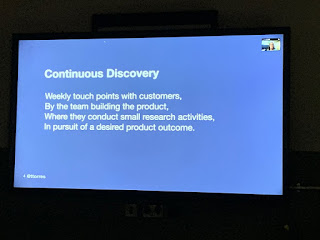MEETUP: Discovery is a mindset not a stage - creating a learning organisation at ProductTank Brighton
Last night was the latest installment of ProductTank in Brighton. We were lucky to have an overview of continuous discovery from Teresa Torres.
She started off by discussing how discovery and delivery should be more intertwined and not separate phases - this can be a problem with “dual track” as it can be impression it gives. She then asked "Continuous discovery ... are you really doing it like this?" Or is it research with a project mindset?
She started off by discussing how discovery and delivery should be more intertwined and not separate phases - this can be a problem with “dual track” as it can be impression it gives. She then asked "Continuous discovery ... are you really doing it like this?" Or is it research with a project mindset?
 |
| Getting better week after week |
We make product decisions every day, so if we want to be truly customer centric then we need to engage with our customers every week so that our decisions are infused with their input. Need to avoid cognitive bias because we are thinking about product all day every day, check the decisions with what our customers expect.
Shooting here for co-creating with a product mindset. Otherwise you can drift into a project mindset by developing in a vacuum, then asking customers to “validate” with a short gap between delivery into engineering. The earlier you get feedback the easier it is to change and the more likely you are to do it ... and not rationalise away what you need to change.
This is not to say customers dictate solutions. We are experts in that. They are experts in their context and problems. This is where we Co create. Two sets of expertise becoming more than sum of their parts.
She then gave an intro to "Opportunity solution tree" - for more details I'd highly recommend her post that goes into how to build one up.
The key is to create one opportunity tree to target one quantifiable metric. The goals is how we must best achieve a business outcome. Then map out customer needs that we think will drive opportunities will meet that need, and the solutions that deliver on that goal. The goal should be a two way negotiation between product leader with the team, leader to set business context etc and the team to communicate how soon/feasible.
Her final tip was when interviewing get them to tell stories - “tell me about a time when” - as it is a better method of collecting insight than how/where/when questions that can be leading. She also recommended starting off every customer contact with this kind of question, before then getting feedback on a specific slice on functionality. To make sure that you gain the generative feedback without leading with your assumptions.
Further reading
- Roman Pichler's Product Discovery Tips
- How to set up a Product Discovery Process? A hands-on, no BS Guide.
- Product Discovery by Marty Cagan
- Product Talk | Make better product decisions.
- Impact Mapping - Similar ideas as Opportunity Solution Trees looking at influencing behaviour


Comments
Post a Comment